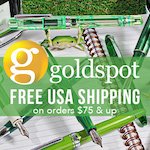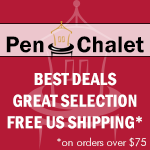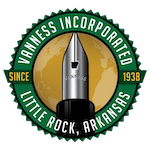The Esterbrook Dollar Pen was one of the pens I acquired at the 2014 Atlanta Pen Show. I didn't really have an Esterbrook on my list when I went to the show, but I went home with two of them. I completely underestimated the charm and unique attributes of these pens, and I just couldn't tear myself away. I had to have them.
A little background
I bought the pens from Carl Daniel at a smaller booth at the back of the room. I remember stopping at the booth several times to handle a few of the pens that were calling to me. He was extremely friendly and offered all kinds of fascinating history tidbits about the pens I was holding. That was part of the allure that snagged me – the history. It put the context in living color.
Esterbrooks weren't on my list before because I really had no interest in antique pens. I had nothing against them, but I hadn't been bitten by the bug. Seeing these pens in person, I pretty much had no choice.
The first model I chose was one of the early "Dollar Pens." From what Carl told me and what I can find online, it's a gray demi model from circa 1939. It's not in perfect, mint condition, and that's part of the allure for me. It's a real pen that's been used. Someone wrote with this, and it still writes today. It has one job, and it does that job with excellence, even ~75 years later.
The nib that came with the pen is a model 1551 – firm medium (student). The nib unit was of an old variety that had a shallow feed. The shallow feeds are apparently prone to leaking, so the vendor included a new-old-stock 2668 nib unit with the pen. I installed the 2668 nib when I got home, and that's all I've been using since.
Now, the pen
I fell in love with this pen the minute I inked it up and started writing with it. I don't know why, but I wasn't expecting it to write so flawlessly. I thought I would possibly end up tweaking and adjusting it a bit before it would write well. No, the pen filled with ink and wrote buttery smooth and consistent from the beginning.
Size
Even though this pen is a short model, it feels like an average full-size pen when posted. When capped, it's somewhere between a TWSBI Mini and a Kaweco Sport. When posted, it's the longest of the three. I've written with the pen for long periods without any complaints. It's a great workhorse pen that I throw in my pen case almost every day. I only paid $30 for the pen, but I treat it like one of my > $100 pens. It's special to me.
Filling mechanism
Ah, the lever filling mechanism. I can't help but make a quick aside about this filling system. As a boy, I loved the scene in Indiana Jones and the Last Crusade where Professor Henry Jones struggles with a solider inside of a German tank, and manages to win the fight by squirting ink in the soldier's eyes. Cheesy, I know, but it's a childhood favorite. I doubt a lever-filler can actually squirt ink with that much force anyway. Back to the point, though.
The lever filling mechanism actually works really well. A small complaint that I have is that it's difficult to get my fingernail under the tiny lever handle sometimes, but that's just a minor gripe. Drop the nib into the ink, work the lever a few times, and you're good to go.
In my experience, the pen doesn't hold much ink. It's definitely much less than a standard Lamy converter, and more like the squeeze converter that comes with the Pilot Metropolitan. Also, another complaint is that you can't tell how much ink is left. You know when the ink starts turning a lighter shade that you only have a few more words left.
Writing
The firm medium nib is a pleasure to write with. There are pens that cost a lot more than this one, and they can't hold a candle to it. I know that each nib is unique and that I might have gotten a little lucky with this one, but that's alright. It's the pen that I have, and I absolutely love it.
The nib is long, which is nice for keeping a good grip on the pen. It's never had a problem starting, skipping, or scratching. I couldn't be happier with it.
And sometimes, depending on the paper and ink combination, the nib acts somewhat like a stub. I've found inks and paper with low saturation properties tend to behave differently with the nib. The tip of the nib is rounded on the top and bottom, but the sides are fairly square. I'm guessing that's what is causing the stub behavior at times. Wet inks do not show any sort of stub behavior, however.
One of the coolest parts about the Esterbrooks is that you can easily swap out the nibs. The nib and feed unit simply unscrew from the section, very similar to how the Edison Beaumont or new Kawecos work.
Overall
This is easily one of my favorite pens, and I'm really glad I took the chance to try one out. It can be a bit nerve-wracking to purchase an antique pen that may or may not actually operate as a functional writing instrument. In my case, I found a good dealer who does a good job of restoring the pens. Being as new to this as I am, I can't really offer any advice other than to find a reputable seller who cares about these pens. If you're fortunate enough to have a pen show near you, that's a fantastic place to see lots of vintage pens and knowledgable, friendly people.
This is one of my favorite new pens, and I can confidently say that I will be expanding my Esterbrook collection.
(You can find more from Jeff online at Draft Evolution, Twitter, and App.net.)















